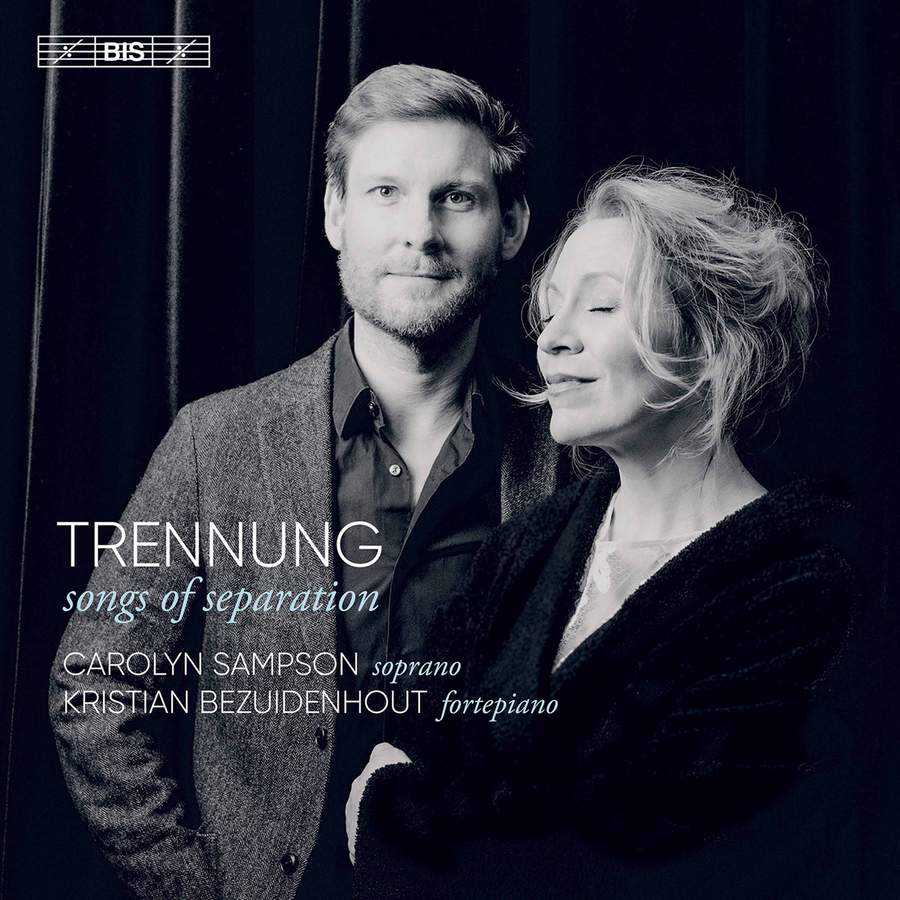Carolyn Sampson: Trennung - Songs of Separation
View record and artist detailsRecord and Artist Details
Genre:
Vocal
Label: BIS
Magazine Review Date: 07/2022
Media Format: Super Audio CD
Media Runtime: 73
Mastering:
DDD
Catalogue Number: BIS2623

Tracks:
| Composition | Artist Credit |
|---|---|
| An den Schlaf |
Friedrich Gottlob Fleischer, Composer
Carolyn Sampson, Soprano Kristian Bezuidenhout, Fortepiano |
| Das Clavier |
Friedrich Gottlob Fleischer, Composer
Kristian Bezuidenhout, Fortepiano |
| Antwort auf die Frage eines Mädchens |
Joseph Haydn, Composer
Carolyn Sampson, Soprano Kristian Bezuidenhout, Fortepiano |
| Arianna a Naxos |
Joseph Haydn, Composer
Carolyn Sampson, Soprano Kristian Bezuidenhout, Fortepiano |
| (12) Lieder für das Clavier, Book II, Movement: Das Leben ist ein Traum |
Joseph Haydn, Composer
Carolyn Sampson, Soprano Kristian Bezuidenhout, Fortepiano |
| (12) Lieder für das Clavier, Book 1, Movement: Die Verlassene |
Joseph Haydn, Composer
Carolyn Sampson, Soprano Kristian Bezuidenhout, Fortepiano |
| Montan und Lalage: Eine Erzählung |
August Bernhard Valentin Herbing, Composer
Carolyn Sampson, Soprano Kristian Bezuidenhout, Fortepiano |
| Abendempfindung |
Wolfgang Amadeus Mozart, Composer
Carolyn Sampson, Soprano Kristian Bezuidenhout, Fortepiano |
| Als Luise die Briefe |
Wolfgang Amadeus Mozart, Composer
Carolyn Sampson, Soprano Kristian Bezuidenhout, Fortepiano |
| An Chloe |
Wolfgang Amadeus Mozart, Composer
Carolyn Sampson, Soprano Kristian Bezuidenhout, Fortepiano |
| (Das) Lied der Trennung |
Wolfgang Amadeus Mozart, Composer
Carolyn Sampson, Soprano Kristian Bezuidenhout, Fortepiano |
| An das Clavier |
Christian Michael Wolff, Composer
Kristian Bezuidenhout, Fortepiano |
Author: David Patrick Stearns
With a mixture of composers both beloved and utterly obscure, Carolyn Sampson and Kristian Bezuidenhout elect to start their often distinguished disc of 18th-century vocal music with a piece whose lack of musical significance is so puzzling as to be intriguing. ‘Montan und Lalage’ by August Bernhard Valentin Herbing (1735 66) is almost nothing but musical oration in its ballad-style telling of a story of lost-at-sea lovers. Though full of dramatic variety in its cantata-like form, this lyricism-challenged 12-minute piece turns out to be a somewhat elucidating ancestor to what ends the disc, Haydn’s similarly scaled but more substantial Arianna a Naxos.
Herbing also provides a showcase for the programme’s performance strategy by Sampson and Bezuidenhout. Never do they oversell the infrequently heard art songs by Haydn and Mozart that, unsurprisingly, turn out to be the disc’s main attractions. Bezuidenhout uses an unimposing fortepiano by Paul McNulty after an 1805 Viennese model by Anton Walter & Sohn whose main expressive option is flexible tempos, which Bezuidenhout employs with such attention to the words that strophic songs never seem repetitive. With support of that calibre, Sampson scales back her tone in the interest of projecting words first and foremost. Vibrato is used for rhetorical emphasis more than for decoration or projection. Using these tools, she presents every song as being delivered by a well-drawn protagonist, and emerges as a master storyteller in one of her more emotionally direct performances on disc. She sings about Herbing’s characters Montan and Lalage as if they’re old friends – and as if she is personally talking to you.
Such qualities are particularly apparent when comparing Sampson’s Haydn Arianna next to Jessye Norman’s (from the album ‘Jessye Norman Live’ – Decca, 6/89). Both make the piece work on their own terms, though I stand back and marvel at Norman’s outpouring of vocal colour, while Sampson draws me into the story. Oddly, Bezuidenhout’s fortepiano conditions one’s ears in ways that make the modern piano accompanying Norman (the distinguished Geoffrey Parsons) sound unconvincingly bloated.
By the end of this ‘Songs of Separation’ disc, the lesser-known composers such as Friedrich Gottlob Fleischer (1722-1806) and Christian Michael Wolff (1707 89) have been a worthwhile listen, especially when Bezuidenhout pairs two like-minded tributes to the clavichord, ‘Das Clavier’ and ‘An das Clavier’ respectively. The generous keyboard-writing, eager word-painting and fascinating chromaticism in the Wolff makes his song the one I most want to hear again. In any case, the lesser works show how Haydn and Mozart shaped and elevated the standard musical and rhetorical techniques of the era, illustrating the difference between a popular art and a potentially timeless one.
Discover the world's largest classical music catalogue with Presto Music.

Gramophone Digital Club
- Digital Edition
- Digital Archive
- Reviews Database
- Full website access
From £8.75 / month
Subscribe
Gramophone Full Club
- Print Edition
- Digital Edition
- Digital Archive
- Reviews Database
- Full website access
From £11.00 / month
Subscribe
If you are a library, university or other organisation that would be interested in an institutional subscription to Gramophone please click here for further information.




